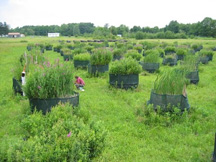Natural Resource/Pitt Ecology Professor Walter Carson Creates Mini-marshes to Protect U.S. Wetlands From Invasive Eurasian Plant

Pitt plant ecologist Walter Carson
Sticky heat rises from the Beagle Road fields, a remote 29-acre site located a few miles from the main camp at Pitt’s Pymatuning Laboratory of Ecology (PLE). Horseflies prowl for blood here. Overheated spittlebugs touch up their frothy coats.
Great place for an intercontinental fight to the death.
In each of the 250 cattle troughs laid out here (each trough holding 500 gallons), the American cattail resists annihilation at the hands of a ruthless Eurasian invader called purple loosestrife.
Pitt ecologist Walter Carson created these battle zones in an effort to help save the millions of acres of North American wetlands currently choked with purple loosestrife. A professor in the School of Arts and Sciences’ biological sciences department, Carson studies competition in plant communities.
His troughs simulate the purple loosestrife’s onslaught on U.S. wetlands in 47 states, including at least 50,000 acres in Pennsylvania, Carson explains. Purple loosestrife debuted in North America as an ornamental plant adored for its towering lavender blooms. Sans a natural enemy on this continent, the voracious perennial invaded marshes, snuffing out native plants such as the cattail and altering ecosystems. Ducks, cranes, and other birds prefer not to nest in purple loosestrife thickets. The broad-leaved plant starves shorter plants, as well as some aquatic animals, of precious sunlight that the tubular cattail allows to pass.
To control purple loosestrife, the U.S. Department of Agriculture in 1993 released in several states—including Pennsylvania—two species of leaf-beetles that eat the plant. When purple loosestrife growth declined in some areas, the USDA ruled the release a success. Yet, no thorough follow-up ever occurred, Carson notes.
His own research found that many marshes lack sufficient numbers of beetles to curb purple loosestrife. Carson surveyed 50 wetlands in Pennsylvania and found only five with enough beetles to control the plant.
Beetle-mania also fizzled in many areas of the Northeast and Midwest, Carson found. Plus, he says, the USDA failed to consider other factors such as soil nutrients in different wetlands—the plant thrives in some soils despite the beetles—and natural enemies of the cattails that the effort was intended to save. For example, some wetlands host a butterfly that eats cattails and hinders that plant’s reclamation of its habitat.
Carson and a student researcher began the minimarshes project in 1999 with funding from a USDA grant. Each trough contains a different concentration of beetles. Carson also filled each minimarsh with a different soil fertility to recreate the various soil types found in natural wetlands.
The Pitt professor hopes to determine the beetle “dose” that best allows cattails to hold their own in the particular soil they call home. A paper detailing the project so far is in the peer-review stage.
“Ecology is easy,” Carson says, “until you try to prove something.”
Pitt plant ecologist Walter Carson (left). Above, the American cattail tries to resist vibrantly colored thickets of purple loosestrife, an invasive species from Eurasia.

The American cattail tries to resist vibrantly colored thickets of purple loosestrife, an invasive species from Eurasia.
Other Stories From This Issue
On the Freedom Road

Follow a group of Pitt students on the Returning to the Roots of Civil Rights bus tour, a nine-day, 2,300-mile journey crisscrossing five states.
Day 1: The Awakening
Day 2: Deep Impressions
Day 3: Music, Montgomery, and More
Day 4: Looking Back, Looking Forward
Day 5: Learning to Remember
Day 6: The Mountaintop
Day 7: Slavery and Beyond
Day 8: Lessons to Bring Home
Day 9: Final Lessons

